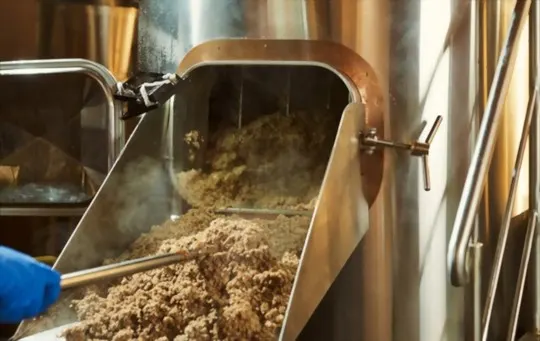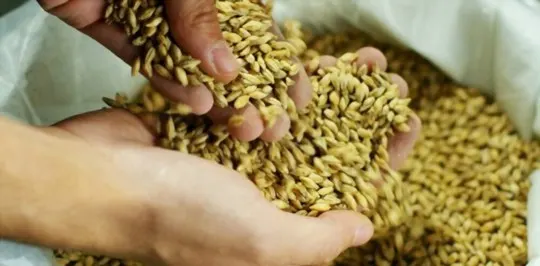Barley’s just a grain, right? Not so fast.
There’s barley, and then there’s malted barley. These two might share a name and a family tree, yet they’re as different as night and day.
Ever brewed beer or baked some bread that smelled like heaven? Malted barley’s the star in those shows.
Now, I’ve had my fair share of brewing experiments. Some were triumphs; others, well, learning experiences.
Barley’s the quiet one in the pantry, waiting for its moment to shine in soups and salads.
Malted barley? It’s the life of the party, turning water into beer.
We’re here to break it down, make it simple.
What is Barley?

Barley: a cereal grain cultivated for over 10,000 years.
Uses vary: animal feed, malted beverages, Asian cuisine.
It’s enriched with fiber, vitamins B and E, minerals like magnesium and selenium.
Different cultivars grown: hulled barley, pot-barley, scotch barley.
Plus, barley can be transformed into malted barley- which has a different set of uses.
It goes through germination, drying, and roasting.
Commonly used in beer or whiskey production due to its flavor profile.
In summary: regular barley & malted barley are different.
Each suitable for diverse purposes- food industry and malting industry.
What is Malted Barley?

Malted barley is a must for beer brewing.
It goes through germination and kilning to unlock enzymes.
These enzymes break starch into fermentable sugars, which yeast eats up during fermentation.
This creates alcohol and carbon dioxide.
Malted barley also gives beer color, flavor, aroma, foam stability, and mouthfeel.
Different malting methods and varieties of barley can alter the characteristics of the beer.
Unprocessed barley is not malted, but can be eaten or used as animal feed.
Differences Between Barley and Malted Barley
Barley and malted barley are two different grains.
Barley is for food and animal fodder.
But malted barley is different.
It’s made by germinating barley seeds and drying them in a kiln.
This gives enzymes for brewing.
Un-malted barley has low enzymes for fermentation.
Malted barley has high levels of enzymes.
Plus, it’s more costly than barley.
Pick the right one depending on your needs.
1 – Processing Method
Barley and malted barley have different processing methods.
Barley is simply cleaned before being used as a grain, whereas malted barley has an extra step called ‘malting.
‘ This involves soaking, sprouting, and drying.
This activates enzymes, which are needed for brewing.
Malting also gives the barley unique flavors and colors.
In conclusion, while they are both forms of the same grain, malted barley offers more complex flavors due to its extra processing step.
2 – Flavor and Taste
Barley and malted barley have different flavors.
Barley has a neutral, slightly sweet taste.
Malted barley has a nutty, sweet flavor with caramel undertones.
This is because the malting process increases the sugar content of barley.
Malted barley is great for beer-making due to its flavor.
Un-malted barley works better in soups and stews.
So, it’s important to pick the right type of barley for the recipe.
Knowing this makes all the difference in the culinary experience.
In conclusion, both types of barley are useful, but malted barley is best when added depth and complexity is desired.
3 – Usage in Brewing and Distilling
Barley and malted barley have unique roles in brewing and distilling.
While barley is a base ingredient for many beers, malted barley adds flavor and enzymes.
This lets brewers and distillers create different drinks.
Malted barley is different from regular barley.
It goes through the malting process, which uses moisture to break down starches into sugar.
This helps with alcohol production.
Malted barley changes a drink’s appearance, aroma, flavor, body, and alcohol content.
But, it costs more than non-malted grains.
Malted barley gives complexity to beer styles like IPAs, stouts, and lagers.
It also adds weightiness to beer’s body.
In distilling, some spirits like Scotch need malted barley to meet regulations.
Barley has lots of uses besides fermentation.
For example, it can be animal feed and a cereal grain.
In ancient times, it was even currency in Iran.
4 – Enzymatic Activity
Barley is an ancient grain, long used for food and beer-brewing.
It still has an important role in agriculture today.
Enzyme activity is an essential part of barley production.
Enzymes in barley activate during malting – a process of soaking, germinating, drying and roasting the grain.
This converts starch into sugars that yeast can use during fermentation to make alcohol.
Non-malted barley enzymes are only active at lower temperatures since they haven’t been malted.
Malted barley is more valuable commercially due to its higher enzymatic activity, making it more efficient for beer brewing and distilling.
But non-malted barley has other advantages: lower price, longer shelf life, and more nutrients due to fewer losses during malting.
In conclusion, both forms of barley have uses – from baking to stock feed.
Malted barley is better for industrial use, but non-malted has its own benefits.
Similarities Between Barley and Malted Barley

Barley and malted barley have many similarities, as well as differences.
Both come from the Poaceae plant family.
They have similar nutritional values and are used in food industries.
Taste-wise, they have a nutty flavor with a slight sweetness.
However, when it comes to brewing, there is a big difference.
Malted barley is germinated and dried, acquiring enzymes for brewing.
Raw barley can’t be used for this, as the enzymes to break down starch into sugar haven’t developed.
Malted barley is also darker in color and more refined than raw barley.
Despite their differences, both types of barley are used around the world in various industries.
Nutritional Value of Barley and Malted Barley
Barley and malted barley may appear similar, yet they differ in nutritional value.
Malted barley is made by sprouting the grain, then halting germination with heat or drying.
This process produces a higher sugar content, making malted barley a key ingredient for brewing beer and other fermented drinks.
Regular barley, however, is high in fiber and protein.
It also contains vital nutrients like B6, iron, zinc, and magnesium.
Studies have suggested that regular barley may reduce cholesterol and help regulate blood sugar.
Malting alters some of regular barley’s nutrients.
Malted barley has much lower dietary fiber than the unprocessed version.
Still, malted barley keeps essential minerals such as potassium and phosphorus.
In conclusion, both regular barley and malted barley contain beneficial nutrients.
They can be incorporated into a balanced diet, or used in different recipes, depending on what you need.
Popular Uses of Barley and Malted Barley
Barley and malted barley are versatile grains, used for diverse purposes.
Barley is a staple food & used in brewing, while malted barley is used to make beer.
Barley can be cooked as cereal, added to soups & stews, or ground into flour.
In the brewing industry, it gives yeast the sugar content it needs to make alcohol.
Malted barley goes through a special germination & drying process, activating enzymes that convert starches into simpler sugars yeast can ferment.
It also brings flavor & color to the final product.
Malted barley is also used in whisky & other spirits, vinegar, bread-making, & baking.
Barley & malted barley have important roles globally.
They provide essential nutrients & complex flavors to foods & beverages.
Conclusion
Barley and malted barley may appear alike, but they have big differences.
Barley is a cereal grain that has not been sprouted or malted.
It is a key component in various dishes, such as beer, animal feed, and human food.
In conclusion, although both originate from the same plant species ‘Hordeum’, they differ greatly in their characteristics during processing.
Therefore, if a recipe calls for ‘barley’, learning more about the recipe’s use of each grain will ensure we can nail the bitterness versus richness.

Leave a comment